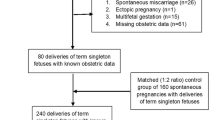Abstract
Purpose
In vitro fertilization (IVF) and to a lower extent gamete intra-fallopian transfer (GIFT) have become routine infertility treatments in industrialized countries. Our purpose is to compare the obstetric and neonatal characteristics of singleton and twin pregnancies after GIFT and IVF with those conceived spontaneously.
Methods
This case-control study was conducted in a tertiary care medical center. The 322 singleton and 78 twin pregnancies after GIFT or IVF from 1991 through 1996 were evaluated and compared with each other, and with a control group that conceived spontaneously and matched for parity, maternal and gestational age. Statistical significance of differences was assessed by χ2 test or two-tailed Fisher exact test. Continuous variables were compared by the paired t-test.
Results
Pregnancy-induced hypertension (PIH) and vaginal bleeding were significantly more frequent maternal complications in the GIFT/IVF singleton groups compared to controls. In twin pregnancies the rate of cesarean sections, vaginal bleeding and preterm labor were more common after GIFT/IVF but did not reach statistical significance. Assisted reproduction was associated with low birth weight only in twin pregnancies when controlled for confounding variables, however perinatal outcome was comparable. There was no significant difference in the outcome measures between GIFT and IVF pregnancies.
Conclusion
After controlling for parity, maternal and gestational age, singleton pregnancies conceived by GIFT/IVF are at increased obstetrical risk, however the perinatal outcome is comparable despite a lower average birth weight.
Similar content being viewed by others
References
Agustsson T, Geirsson RT, Mires G (1997) Obstetric outcome of natural and assisted conception twin pregnancies is similar. Acta Obstet Gynecol Scand 76:45–49
Bayerische Perinatalerhebung [Bavarian Perinatal Registry] (1995) Bayerische Landesärztekammer, Munich
Bernasko J, Lynch L, Lapinski R, Berkowitz RL (1997) Twin pregnancies conceived by assisted reproductive techniques: maternal and neonatal outcomes. Obstet Gynecol 89:368–372
Dhont M, De Sutter P, Ruyssinck G, Martens G, Bekaert A (1999) Perinatal outcome of pregnancies after assisted reproduction: a case-control study. Am J Obstet Gynecol 181:688–695
Doyle P, Beral V, Maconochie N (1992) Preterm delivery, low birthweight and small-for-gestational-age in liveborn singleton babies resulting from in-vitro fertilization. Hum Reprod 7:425–428
Fitzsimmons BP, Bebbington MW, Fluker MR (1998) Perinatal and neonatal outcomes in multiple gestations: assisted reproduction versus spontaneous conception. Am J Obstet Gynecol 179:1162–1167
Goldman JA, Ashkenazi J, Ben-David M, Feldberg D, Dicker D, Voliovitz I (1988) First trimester bleeding in clinical IVF pregnancies. Hum Reprod 3:807–809
Isaksson R, Gissler M, Tiitinen A (2002) Obstetric outcome among women with unexplained infertility after IVF: a matched case-control study. Hum Reprod 17:1755–1761
Koivurova S, Hartikainen AL, Gissler M, Hemminki E, Sovio U, Jarvelin MR (2002) Neonatal outcome and congenital malformations in children born after in-vitro fertilization. Hum Reprod 17:1391–1398
Koudstaal J, Bruinse HW, Helmerhorst FM, Vermeiden JP, Willemsen WN, Visser GH (2000) Obstetric outcome of twin pregnancies after in-vitro fertilization: a matched control study in four Dutch university hospitals. Hum Reprod 15:935–940
Maman E, Lunenfeld E, Levy A, Vardi H, Potashnik G (1998) Obstetric outcome of singleton pregnancies conceived by in vitro fertilization and ovulation induction compared with those conceived spontaneously. Fertil Steril 70:240–245
McFaul PB, Patel N, Mills J (1993) An audit of the obstetric outcome of 148 consecutive pregnancies from assisted conception: implications for neonatal services. Br J Obstet Gynaecol 100:820–825
McMahon CA, Ungerer JA, Beaurepaire J, Tennant C, Saunders D (1997) Anxiety during pregnancy and fetal attachment after in-vitro fertilization conception. Hum Reprod 12:176–182
Moise J, Laor A, Armon Y, Gur I, Gale R (1998) The outcome of twin pregnancies after IVF. Hum Reprod 13:1702–1705
Nolte E, Brand A, Koupilova I, McKee M (2000) Neonatal and postneonatal mortality in Germany since unification. J Epidemiol Community Health 54:84–90
Nygren KG, Andersen AN (2002) Assisted reproductive technology in Europe, 1999. Results generated from European registers by ESHRE. Hum Reprod 17:3260–3274
Olivennes F, Rufat P, Andre B, Pourade A, Quiros MC, Frydman R (1993) The increased risk of complication observed in singleton pregnancies resulting from in-vitro fertilization (IVF) does not seem to be related to the IVF method itself. Hum Reprod 8:1297–1300
Reubinoff BE, Samueloff A, Ben-Haim M, Friedler S, Schenker JG, Lewin A (1997) Is the obstetric outcome of in vitro fertilized singleton gestations different from natural ones? A controlled study. Fertil Steril 67:1077–1083
Tallo CP, Vohr B, Oh W, Rubin LP, Seifer DB, Haning RV Jr (1995) Maternal and neonatal morbidity associated with in vitro fertilization. J Pediatr 127:794–800
Tan SL, Doyle P, Campbell S et al (1992) Obstetric outcome of in vitro fertilization pregnancies compared with normally conceived pregnancies. Am J Obstet Gynecol 167:778–784
Tough SC, Greene CA, Svenson LW, Belik J (2000) Effects of in vitro fertilization on low birth weight, preterm delivery, and multiple birth. J Pediatr 136:618–622
Verlaenen H, Cammu H, Derde MP, Amy JJ (1995) Singleton pregnancy after in vitro fertilization: expectations and outcome. Obstet Gynecol 86:906–910
Wang JX, Clark AM, Kirby CA et al (1994) The obstetric outcome of singleton pregnancies following in-vitro fertilization/gamete intra-fallopian transfer. Hum Reprod 9:141–146
Acknowledgement
This article is dedicated to Prof. Dr. H.-G. Hillemanns, F.R.C.O.G., on the occasion of his 80th birthday.
Author information
Authors and Affiliations
Corresponding author
Rights and permissions
About this article
Cite this article
Ochsenkühn, R., Strowitzki, T., Gurtner, M. et al. Pregnancy complications, obstetric risks, and neonatal outcome in singleton and twin pregnancies after GIFT and IVF. Arch Gynecol Obstet 268, 256–261 (2003). https://doi.org/10.1007/s00404-003-0518-5
Received:
Accepted:
Published:
Issue Date:
DOI: https://doi.org/10.1007/s00404-003-0518-5




